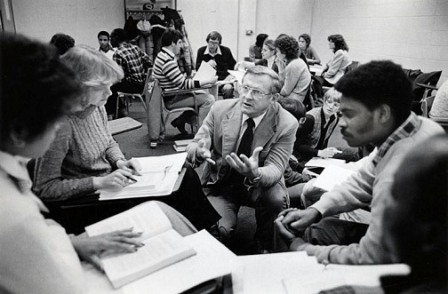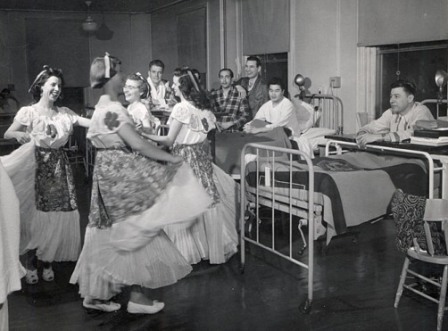In 1996, I spent some time at the University of Wisconsin at Madison working in the archives for my dissertation research. I was studying the origins and early development of the Cooperative Extension System's civic mission. Looking through a collection of papers about county extension work, I found what I thought was a treasure trove: a dozen or more boxes of detailed annual reports that county agents had sent in to Madison in the 1920s and '30s. At lunch that day, a friend introduced me to Jerry Apps, a professor of extension education who was working at the time on a history of Cooperative Extension in Wisconsin (his study was published in 2002 as The People Came First).
Excitedly, I told Jerry about the reports I'd just found. He wasn't impressed. Then he told me something I've never forgotten:
"You need to remember that there are two kinds of Extension reports," he said. "There are the ones that are sent in to campus. And then there are the ones that aren't."
He leaned toward me and looked me in the eyes. In a quiet voice, like he was telling me a secret, he said, "Guess which ones are more important."
Jerry Apps teaching class in Wisconsin (no date).
Photo courtesy of the UW-Madison Archives #S10345.
I got the message. And the lesson.
The message was simply that we should never make the mistake of thinking that what's in official reports about Extension (or anything else, for that matter) is the whole story. Or sometimes even the real story. And that we should never confuse official reports, mission statements, theories, lists of goals and objectives, and the like with actual practice.
The lesson, as I took it, was to look and ask for the second kind of report that Jerry named. As I thought about it later I realized that the second kind of report comes in a particular form: stories.
So the real lesson isn't to look or ask for a report at all. Rather, it's to look and ask for stories that usually don't get included in reports. Stories of life and work and experience that people tell when they are invited to be more fully themselves, to not just perform their scripted roles and positions, but reflect and talk as people who have particular experiences, hopes, passions, interests and commitments, and who see and struggle to make sense of life's drama, comedy, tragedy, beauty and humor.
Students from the Racine Extension Center dance in costume for patients at the Waukesha veterans' tuberculosis hospital (Wisconsin 1951). Photo courtesy of the UW-Madison Archives #S09414.
The hope and bet for me in this lesson was that by looking and asking for stories that don't make it into official reports, three questions might be better answered: What is Extension? What is it for? Why does it matter? These questions were and still are the most fundamental ones we can ask about Extension. And the most important.
Together with many collaborators, most of them students at Cornell University, I spent more than a decade conducting and interpreting oral histories of the work and experiences of Extension faculty and staff. What I learned from their stories, many of which have been published, is that Extension work isn't just about the provision of information or "applied" research, or the development and implementation of "evidence-based programs." It's not just about technology transfer and technical problem solving for economic ends. And it doesn't matter only for economic reasons.
All these things aren't wrong or bad, of course. In fact, they're incredibly important. They're part of what makes Extension useful and valuable. But the stories my colleagues and I have heard and collected reveal so much more. They show us that at its best, Extension also includes and is about the cultivation of civic agency and the development, growth and creative expression of people and communities. And that this means that Extension matters for reasons that reach beyond economics to include the pursuit of a set of rich civic and cultural ideals and values, including something we say as Americans that we stand for and believe in: democracy.
If you find this surprising, listen to something that C.B. Smith, who served as Chief of the Office of Extension Work at USDA during the 1920s and '30s, said in a speech he delivered at the University of Minnesota in 1939:
Probably the biggest thing that adult Agricultural Extension and 4-H club work are doing for individuals and the Nation is not so much the growing of better crops or the rearing of better livestock or the making of better kitchens, but rather the giving of actual experience in the practice of democracy ... And it has done so not by telling people about democracy or preaching about it, but by actually practicing democracy in all phases of its work and developing its Extension program down to the smallest community and individual farm through democratic processes. And this practice of democracy in Extension since 1914 has come about because democratic processes from the outset were in the minds and hearts of those State and Federal officers administering the law and native to them.
And listen, too, to what Ruby Green Smith said in 1949 in The People's Colleges, her newly republished history of Extension work in New York:
Extension workers need to have faith in spiritual values and to recognize the human relationships that contribute to what the ancient Greeks called 'the good life.' They should believe that in the kind of homes, farms, and industries which are the goals of extension service 'man cannot live by bread alone'; that it is not enough for people to have food, shelter, and clothing--that they aspire also to find appreciation, respect for individuality and human dignity, affection, ideals, and opportunities. These are the satisfactions that belong to democratic living.
As we reconsider Extension in relation to the centennial in May of 2014 of the Smith Lever Act, which established the national Cooperative Extension System, it would serve us well to remember these words from C.B. Smith and Ruby Green Smith (they weren't related, by the way). They remind us of fundamental values and ideals that were embraced by women and men who have come before us, even if they were never fully or perfectly realized due to ordinary human failings and flaws we still struggle to overcome, and to anti-democratic forces that are still with us.
In the spirit of the lesson I learned long ago from Jerry Apps, we hope in Imagining America's Extension Reconsidered initiative to find and hear stories that can help us see and understand what usually gets left out of official reports. Stories that will help us gain a richer and larger sense of what Extension is, what it's for, and why it matters as it begins its second century. Stories that show us how the "satisfactions that belong to democratic living" that Ruby Green Smith wrote so eloquently about some 65 years ago are still being pursued in and through Extension work.
This post originally appeared on the Extension Reconsidered blog at Imagining America.
--
Extension Reconsidered is a partnership between Imagining America, the Kettering Foundation, the Engagement Scholarship Consortium, Community-Campus Partnerships for Health, and Art of the Rural.

